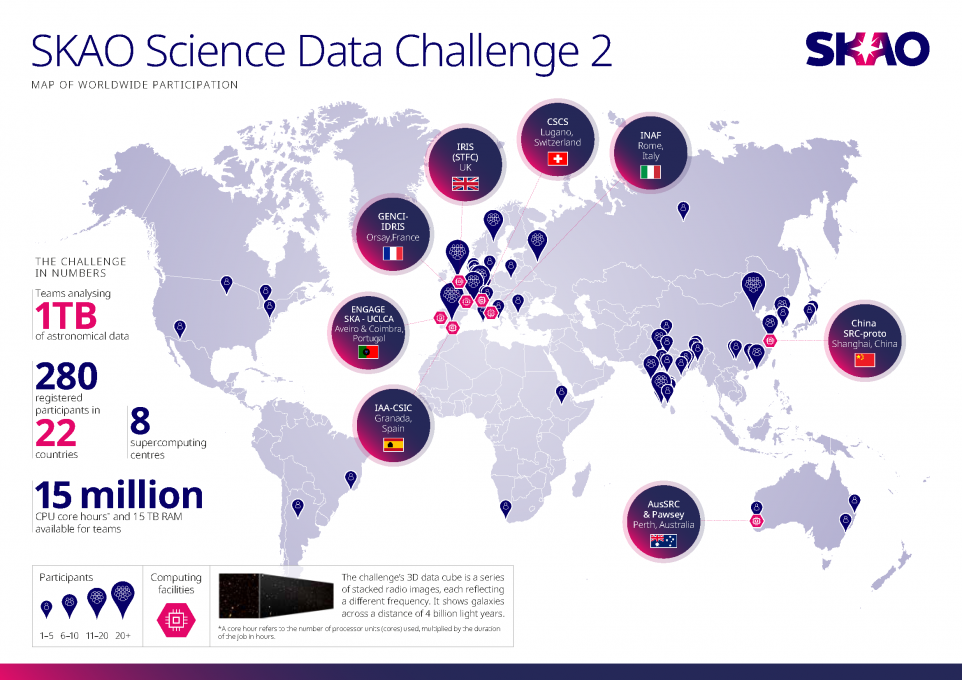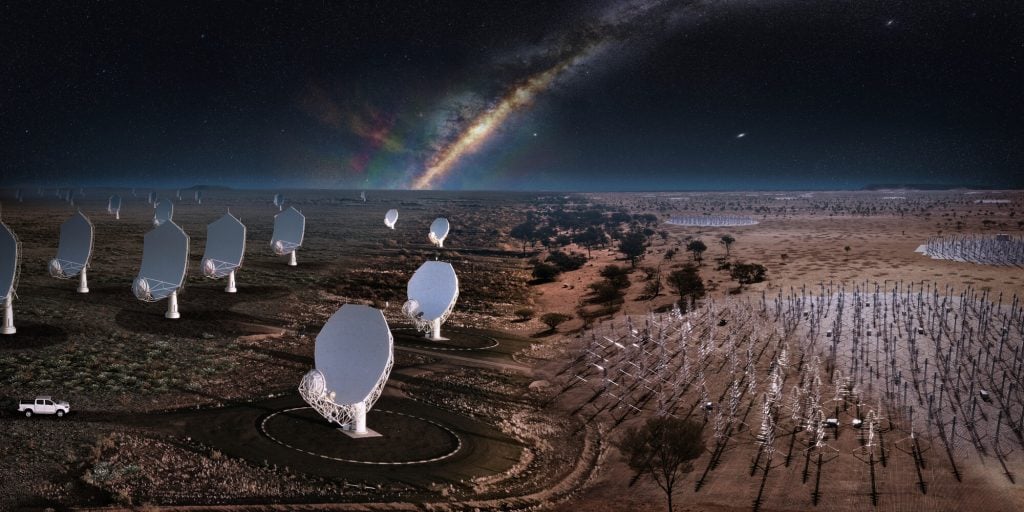
The SKA project’s radio astronomy observatory is announced as one of the largest machines on earth. It will span a square kilometre, as its name suggests: Square Kilometer Array. SKAO, the SKA observatory, will provide scientists with data of unprecedented quality, quantity and diversity. This year, the second edition of theSKAO Data Challenge (SDC2)was organized , in which scientists from all over the world took part. The MINERVA team from Paris Observatory/PSL, together with the CNRS, the Observatoire de la Côte d’Azur, the Strasbourg Astronomical Observatory and the Canadian Institute for Theoretical Astrophysics, won the challenge thanks to an innovative algorithmthat benefited from the expertise of the Jean Zay GENCI-IDRIS/Centre National de la Recherche Scientifique supercomputer.
The SKA Radio Astronomy Observatory (SKAO) instruments were designed from 2012 to 2020 by the SKA Organisation, a company with members from 14 countries (including CNRS for France) and collaborating with around 100 organisations from over 20 countries. It is in anticipation of the scientific exploitation of SKAO that the SKAO Data Challenges (SDCs) are organized in order to ensure maximum exploitation of the data as soon as the telescopes enter the initial exploitation phase and to boost the development of data analysis techniques. The SDCs are also useful in the IT area to prepare the systems and processes needed for the network of SKA Regional Centres (SRCs) that will store, process and provide access to data for astronomers around the world.
280 participants from 22 countries
No less than 40 teams, made up of 280 participants from 22 different countries, took part in this second edition of TCS2, which began last February and lasted six months. They were supported by eight major computing centres around the world, providing the storage and processing resources that were essential for the challenges to run smoothly.
The teams had to develop algorithms capable of identifying and characterizing nearly 250,000 galaxies in a 1 TB data cube, derived from a simulated SKAO spectro-imaging observation in the wavelength range around the 21 cm line of the hydrogen atom.
Teams were scored on two elements which, combined, gave the final TCS2 score. These two elements were the number of objects identified (with a penalty for false positives) and the accuracy with which the various characteristics of the objects, for example their size or brightness, were measured.

Infographic representing the participation in the SKAO Science Data Challenge 2. A total of 40 teams comprising 280 participants from 22 countries took part in the 6-month challenge. They were supported by eight computing facilities to identify and characterize nearly 250,000 galaxies in a simulated 1 TB data cube.
A great success for the MINERVA project
On October 13, 2021, SKAO announced that SDC2 was won by a French team that benefited from the MINERVA project funded by Observatoire de Paris – PSL and using the resources of GENCI’s French national supercomputer Jean Zay, one of the most powerful operational European supercomputers converging High-Performance Computing (HPC) and Artificial Intelligence, operated and hosted by the CNRS’ Institut du Développement et des Ressources en Informatique Scientifique (IDRIS). The objective of the MINERVA project is to explore the use of machine learning in various fields of radio astronomy, with a particular focus on the preparation of SKAO. Philippe Lavocat, CEO of Genci said:
“While 1,000 hours of GPU computing resources have been allocated by IDRIS to the MINERVA project to enable the development of a machine learning method to better address the needs of astronomical images, this success heralds very promising future developments between HPC/AI and large-scale scientific instruments in the SKA project, in line with GENCI’s strategic plan.”
The winning team also included collaborators from the University of Toronto and the Observatoire Astronomique de Strasbourg. It won TCS2 by developing two pipelines in parallel, both based on convolutional neural networks (CNN).
The first one is an improved version of YOLO, the object detector, adapted to the specific needs of astronomical data and generalized in 3D, while the second one combines several ad hoc networks implemented only for TCS2. The merging of the catalogues resulting from these two NCs gave the highest score for TCS2.
The development of the algorithm was carried out on local resources at Paris Observatory – PSL, while the processing of the full 1 TB SDC2 data cube was carried out on the Jean Zay computer at IDRIS using up to 25 GPUs simultaneously. Antoine Petit, CEO of CNRS, congratulates:
“It is a great pleasure to see the interactions between astronomers and computer scientists in our laboratories, encouraged by the SKA project. The challenges posed by radio astronomy are attracting more and more attention from the computer science community. CNRS, with its strong interdisciplinary capabilities, is in a very good position to provide the important developments necessary for the advent and success of SKA.”
SKAO, which officially began work on July 1, 2021, will be an observatory operating two telescopes composed of large antenna arrays (more than 131,000 antennas in Australia, SKA-LOW, and just under 200 parabolic antennas of about 15 m in diameter in South Africa – SKA-MID), capable of globally capturing the electromagnetic radiation emitted by celestial objects between 50 MHz and 15.4 GH
SKA nighttime composite image combining all features in South Africa and Australia. SKAO, ICRAR, SARAO
France in the SKAO project
In May 2021, after a unanimous decision of the SKAO Council, France was the first country to join the seven founding members (Australia, China, Italy, the Netherlands, Portugal, South Africa and the UK).
Frédérique Vidal, Minister of Higher Education, Research and Innovation had announced on February 4, 2021 the commitment of France in the SKAO application process, work having been carried out by the CNRS with this objective, during the first SKAO Council meeting and it is now an undeniable actor of this project. DR C. Ferrari, director of Ska-France and astronomer at OCA states:
“The participation of France in SDC2 is a good example of the joint efforts we aim at by coordinating SKA-related activities in France. The collaboration of astronomers, developers, engineers from different research and infrastructure institutes will be paramount for the future organization of the SKA regional centers, the global network of computing and data infrastructure that will allow astronomers to access and fully exploit the scientific products of the SKA Observatory.”
The research laboratories that participated in the French team’s victory at SDC2:
- Laboratoire d’étude du rayonnement et de la matière en astrophysique et atmosphères (Observatoire de Paris – PSL/CNRS/Sorbonne Université/CY Cergy Paris Université),
- Laboratoire Galaxies, Etoiles, Physique, Instrumentation (Observatoire de Paris – PSL/CNRS)
- Strasbourg Astronomical Observatory (CNRS/University of Strasbourg)
Institut du Développement et des Ressources en Informatique Scientifique (IDRIS-CNRS) - UAR Galilée (Université Côte d’Azur, Observatoire de la Côte d’Azur, CNRS)
Translated from Une équipe française du projet MINERVA remporte le SKAO Data Challenge 2021 en utilisant le supercalculateur Jean Zay










